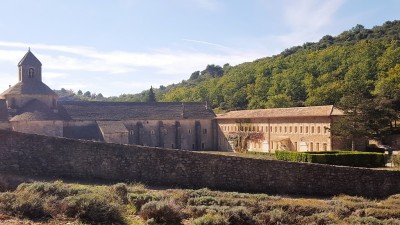
Abbaye Notre-Dame de Senanque
Here I sit, on a rainy evening in Gordes, very happy to be cozy inside and listening to the rain fall outside.
Yesterday was a brilliantly sunny day. I actually got to wear a summer dress that I got at a second hand store at home with Provence in mind. But first, we started the day with a power walk close to home. It led past some very beautiful and expensive looking estates with well cared for gardens. There was a stone brick fence that ran along the road for miles. It went between many properties and made me wonder if it was private or public, who knows? We found a little path through the trees and took it. It led to a back way into Gordes. I have a feeling that one could explore Provence on these tiny back paths for many, many miles. But that’s an adventure for another time.
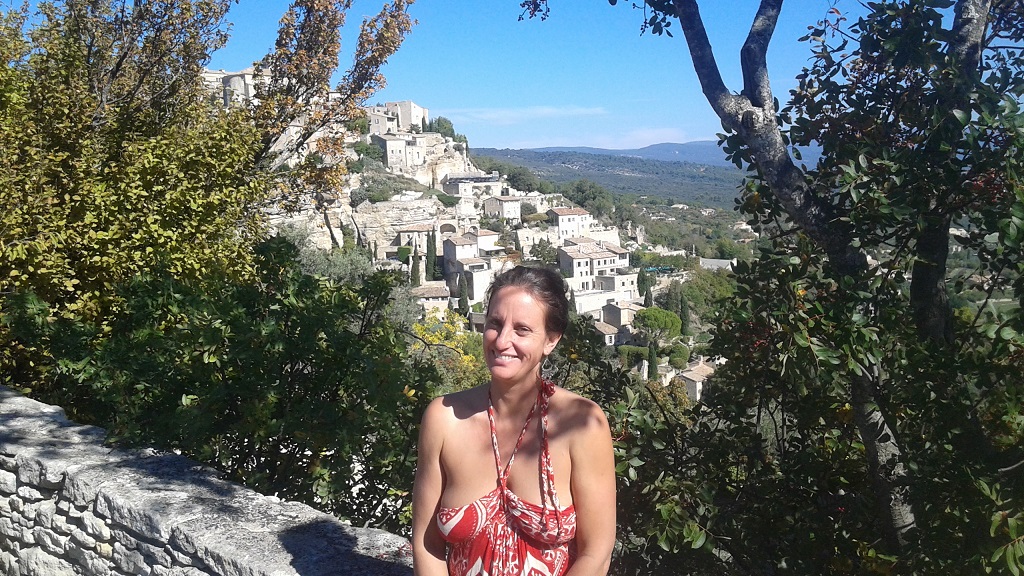
Ambling Through Villages on a Sunny Provencal Day
Dan emailed Aileen to tell her that we couldn’t get the keys working and the home wouldn’t lock, but knowing it was Sunday and Provencal citizens move to the beat of their own drum, we weren’t shocked that we didn’t get a response. We threw in a load of laundry and discovered that the wash cycle takes three hours. Not wanting to wait all day for one load of wash, we left to see the sights. I have determined that all meals take forever in France (even what you would think would be a quick bite to eat), and apparently, so does a washing machine. Good grief!
The day was spent exploring the attractions outside Gordes and I liked sticking close to home. First, we went to the Village des Bories. Bories are basically stone huts. There are over 1,600 known ones in Provence. The Village des Bories is a cluster of them and there were signs indicating what specifically they were used for. Goat homes, pig homes, people homes, wine storage, tool storage, silk production. The bories were built between the 1600’s-1800’s – and abandoned in the mid-1800’s. When farmers cleared their fields, rocks were dug up and used to build bories. The bories use no mortar and it is a real art to get them stacked in a way to provide structure. They were even made weather proof by stacking the stones in a certain way. The bories in the Village were abandoned in the 1800’s and rediscovered in the 1960’s by a poet. He loved the story behind the bories and bought up the land and spent eight years spearheading the restoration of them. In the years that they were neglected, plants began to grow in them, much like how the forest took over Angkor Wat (although not as large and dramatic). The assemblage of bories has since been transformed into an open air museum, so we can all enjoy it. Very worthwhile.
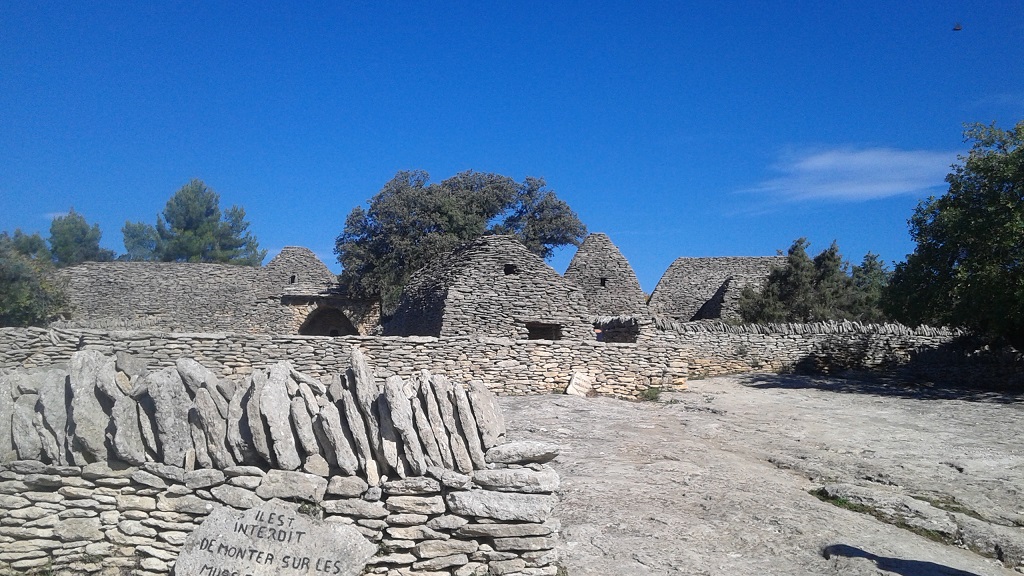
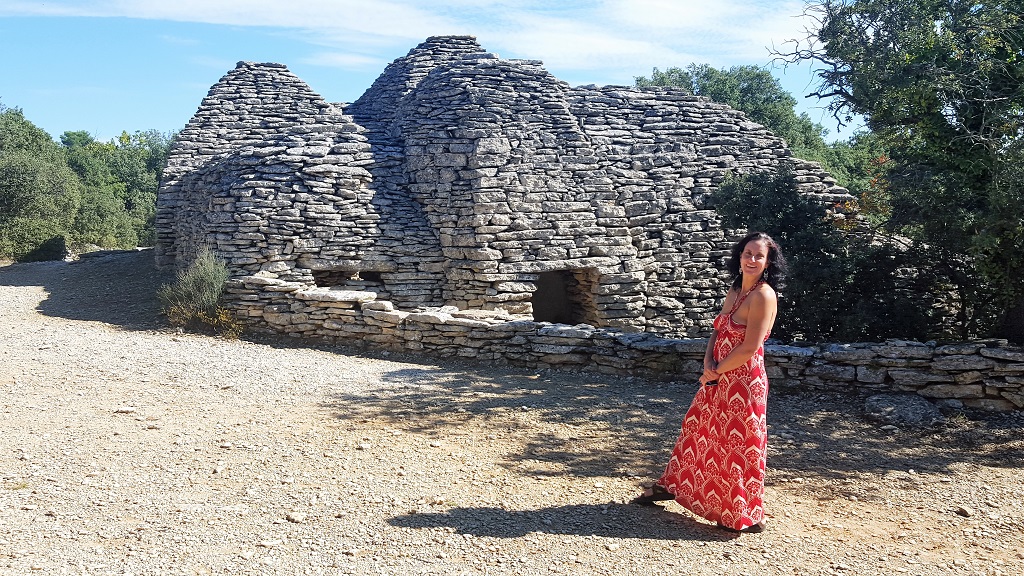
The Bories are Essentially Stone Huts
We went to the olive oil museum and I guess we just have not quite gotten in the hang of the two hour lunch hour. It was closed, but, with driving slowly on these country roads, it gave the opportunity for the laundry to finish, so we made a quick pit stop to hang the clothing outside.
After taking care of the laundry, we went to Abbaye Notre-Dame de Sénanque, which is a modest abbey, built around 1100 AD in a secluded valley. It is surrounded by lavender plants and, when I got there, I realized I had seen pictures of this abbey, anytime I had googled images of “Provence lavender.” It is a pensive place and they request that visitors are silent. Seeing the walls of climbing ivy turn fire engine red made me reminiscent of east coast autumns and perhaps, just perhaps, it could rival the hues of lavender in the summer. We sat inside the abbey for a bit by ourselves. It was very basic and lacked any ornamentation that the larger churches have in big cities. I believe this type of church is more about prayer and solitude and less about making an impression to the world.
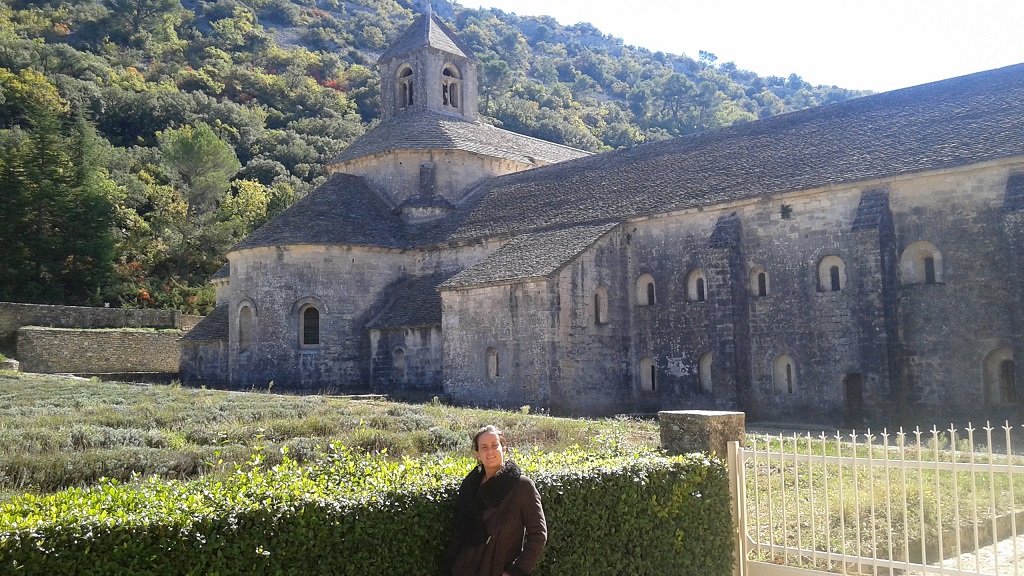
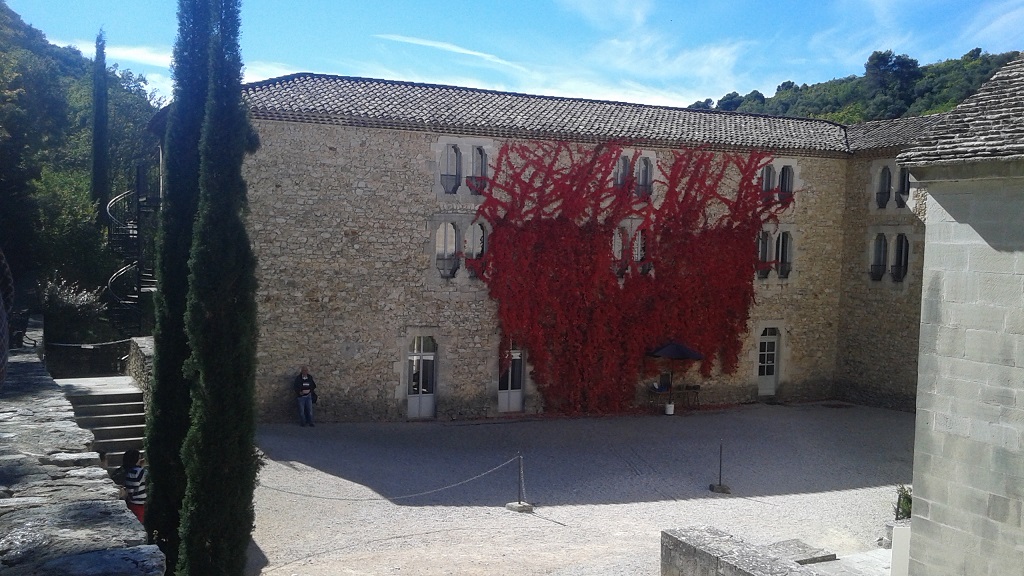
While the Purple Lavender is what Provence is Famous For, it’s the Red Ivy that Gets My Attention
Time ticked away and lunch was over at the museums, so we headed back to the olive oil museum. I am a big lover and believer in olive oil and I knew I would soak this up, no pun intended. The building was actually built by the Romans in about 100 AD for the purpose of pressing olive oil. Their ancient press was there and then there was another 30 foot press (made from an oak tree) that was used in the 1600’s. Another press, which was circular, about ten feet in diameter was used in the 1800’s.
There are about 500 types of olives, most of which come from the Mediterranean region. And between the time at which they are harvested and how they are cured, the taste of any one olive can vary greatly and have half a dozen expressions, if you will. So with all the varieties out there, there are a couple thousand types of finished products in the cured olive world. I love it!!
I asked the woman who was giving us our private tour, if the French think of olives in a similar way that they think of grapes and wine. Very particular about the nuances of when and how and what goes into the growing and harvesting and processing of them. I was pretty sure what her answer would be, but I wanted to see what she had to say. She said that yes, people in the olive industry were very particular and they cared very much about the shades of color and if the oil for example gave off a flavor and/or aroma that was like walnuts or artichoke or herbaceous. The terroir was Très Importante.
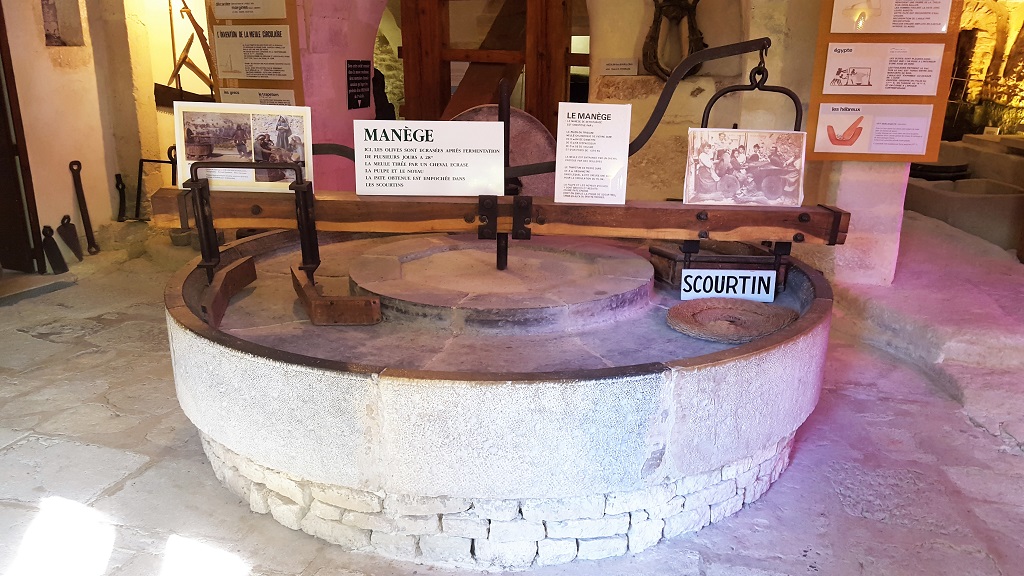
A Olive Oil Press Used in the 1800’s
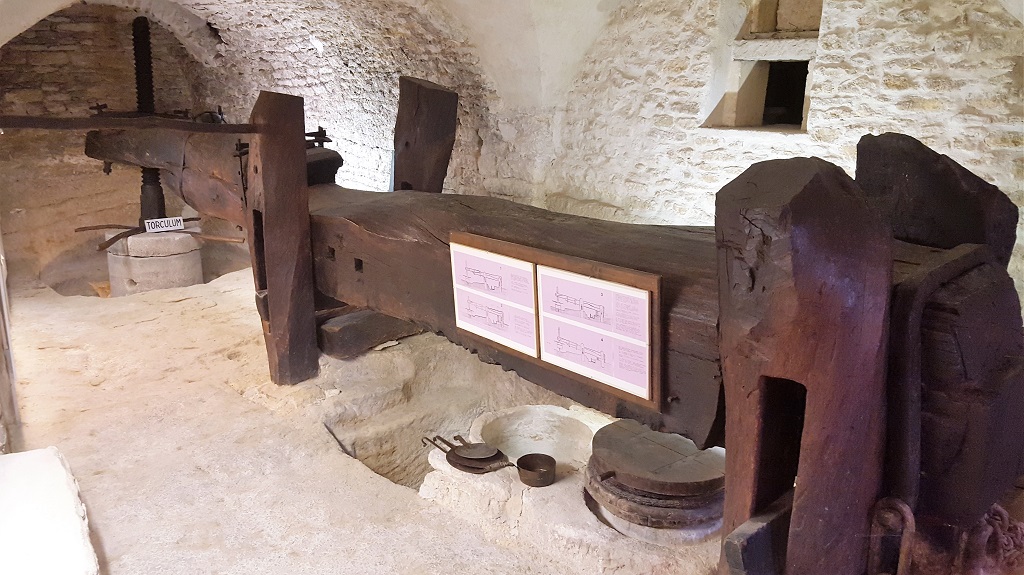
Olive Oil Press from the 1600’s
This property has a similar back story as the Village des Bories. A woman, Frédérique bought the dilapidated olive mill in 1958 and restored it and turned it into a museum. She also happened to be a sculptor and a glass artist and she opened a glass museum on the same property. It is an unlikely stacking of business models, but somehow, it works. So we walked past the sculptures to get to the glass museum.
Now this is interesting. In about 4500 BC, the Mesopotamians (present day Syria and Iraq) were making bricks for building in these stone ovens. They were using a plant, that the French call silicorn, as the fuel to heat the sand to 1400 degrees Fahrenheit. The plants went under the stove, but one of these times, the plants got mixed with the sand, and when it hit 1400 degrees, glass was formed. With the energy demands of creating glass, it was something rare and labor intensive for many years. Even through WWI, the French were using heavy paper for their windows, because they couldn’t afford glass. So it has only been the last century that glass has been widely available and used.
Obtaining and mixing the minerals to turn glass translucent or colored is a science unto itself. The same mineral can be added at different points in the cooling process, and a different color will result. Before the temperature could be measured with precision, it was only certain glass artists that could do this work. If they ever went missing, even for a day, they were suspected of foul play and a bounty was out for them. This museum didn’t allow pictures. It is the size of a medium sized warehouse and it is filled with all sorts of artifacts, as well as Frédérique’s work. Worth a gander.
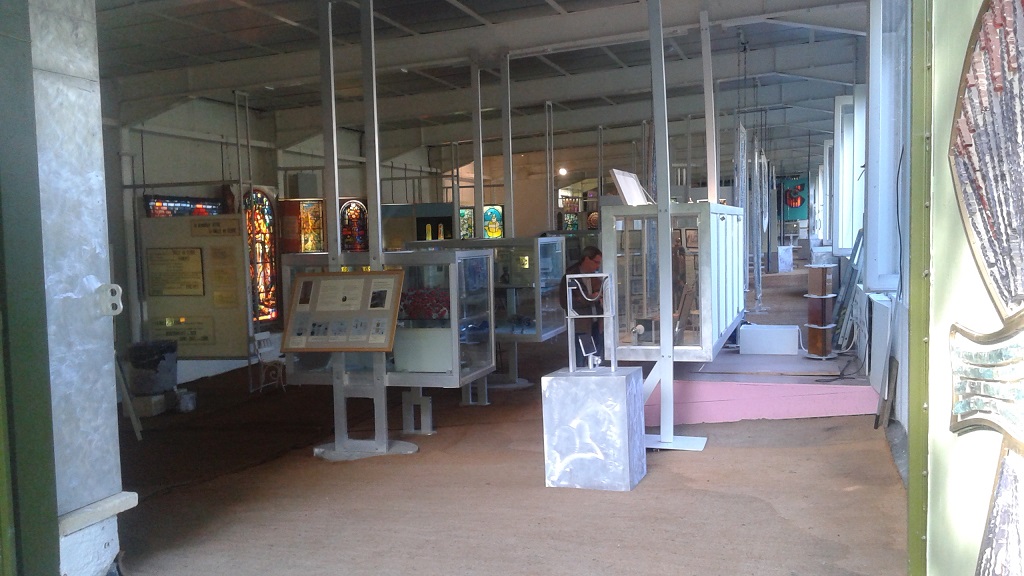
A Peek into the Glass Museum
Nearby was a lavender museum. I have loved and used lavender for many years. My favorite thing to do with lavender is to make lavender crème brulée – it’s to die for, but then again, it’s hard to go wrong when we are talking egg yolks and cream. This museum is run by a company that grows lavender and processes it to make essential oil. They really pushed the distinction that the lavender that grows wild in Provence is the real stuff and that the cultivated plants at lower elevations are not medicinal in nature and merely acceptable for industrial purposes (to scent laundry detergent, for example). While I do think there is a difference in wild and cultivated plants and differences in varieties of the same plant (Lavendula officinalis, Lavendula angustifolia), I have a hard time believing that there is not a common thread that ties them together. That flies in the face of what else I have learned about herbs through the years.
Inside the museum, there were examples of close to 20 different stills, from through the ages, as well as interesting information and stories about each one. There was also a movie about how the lavender oil is produced, starting from harvesting the lavender flowers from the perennial bushes each summer. It was obvious from watching the movie, that this particular company practices large scale agribusiness. They were super pushy about trying to get people to buy their products, as they exited the museum and entered the gift shop. Ironically, I can’t stand pushy sales people and when confronted with them, I get out of dodge ASAP. Nonetheless, an interesting stop along the way, if you are a lavender admirer.
We got home and wanted to relax by the pool for a bit before leaving for dinner. It was too late in the day to get in the water but we enjoyed sitting in the sun on the lounge chairs and we talked about having only a half day of adventuring tomorrow, so we can actually take advantage of the pool, the main attraction of this place.
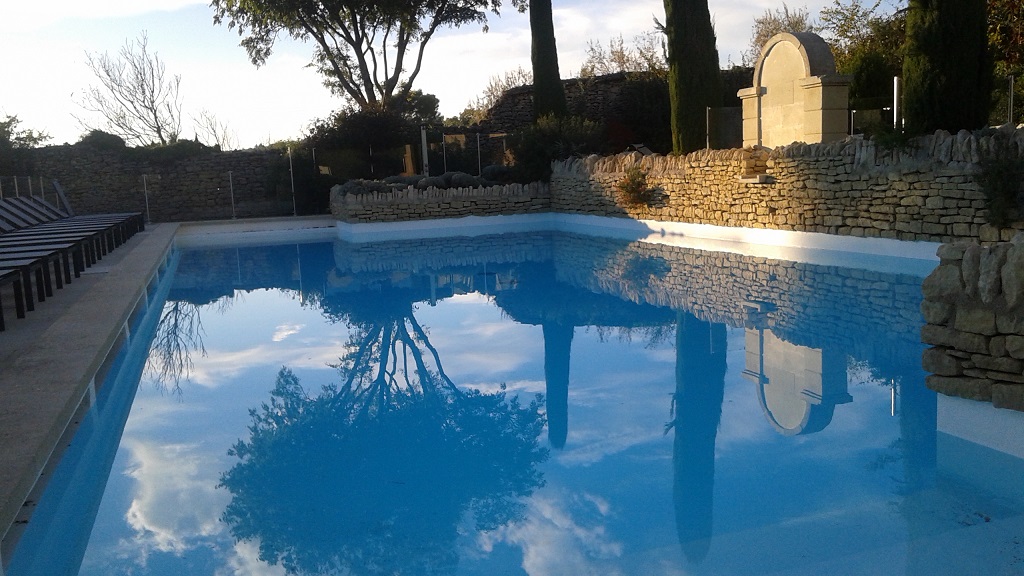
Chilly but Beautiful Pool
We headed off to the town of Cucuron to go to La Petite Maison de Cucuron. It wasn’t far in distance, but these winding roads make for a modest paced drive. And it didn’t help that Miss Google took us up some narrow-assed one way streets with hairpin turns,and it took forever to get back to the proper traffic circle. Americans who refuse to part ways with their SUV’s are going to hate attempting to drive on medieval streets.
The chef at La Petite Maison, Eric Sapet has studied with Dominic Bouchet and we planned on eating at Dominic’s when we returned to Paris. So, in the interest of connecting the genealogy of chefs, Eric is on our radar. The restaurant is in a rustic looking, pale yellow building and has lots of wood décor in it. The food was very tasty but not out of this world. The service left some things to be desired, especially taking into account it is a Michelin starred restaurant. While we liked the meal, it is not necessary to describe it in full detail. It was no Anne-Sophie or Alain,
However, there are a couple things I will note about the food. I was eating mallard de chasse, which translates into duck of the hunt. Dan was just about to tell me that this is a hunted duck, not a cultivated duck, and that there may be a shotgun pellet in it, when I took something out of my mouth that I bit into when eating the duck. A silver little ball, I declared, and I am happy I didn’t crack a tooth on it, which could have happened very easily. Well, to the credit of the restaurant, they offered full disclosure and it was not their responsibility that I didn’t comprehend what it meant. Another thing to note is that we got to sample a new cheese, which is Provence’s only AOC certified cheese. It is called Banon. It’s made with goat’s milk and part of its receiving the AOC label (this is the institution that proclaims champagne is from Champagne and Roquefort is from Roquefort, in the mid-Pyrenees) is that this cheese needs to be wrapped in chestnut leaves and tied with raffia. As usual, the cheese course is served when I am no longer hungry, but we did taste it, and would eagerly indulge again in Banon at another more opportune time.
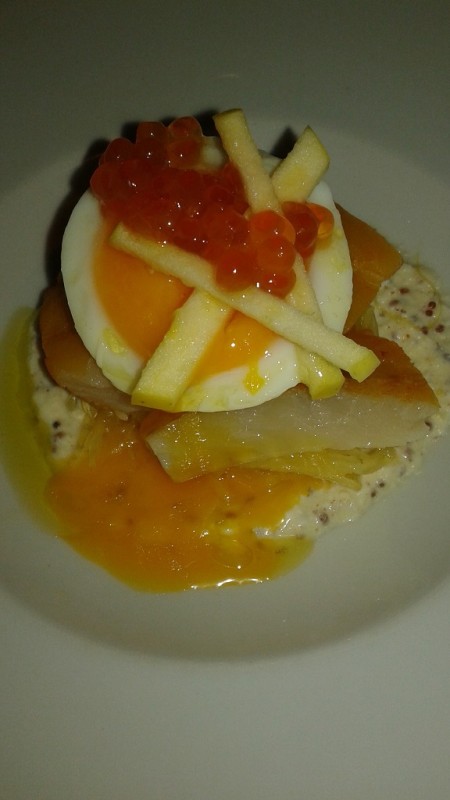
Egg and Caviar with Accompaniments
Leaving the restaurant, we walked around the pond nearby which is lined with large and gracious sycamore trees. And when we got home, we did another more extensive walk down the road, admiring Gordes (which still had some lights on) across the way. Being so far away from a city, the stars were abundant in the clear skies. We talked about a variety of topics and of course made mention how lucky we were to be enjoying Provence and all the beauty and adventure that it has to offer.
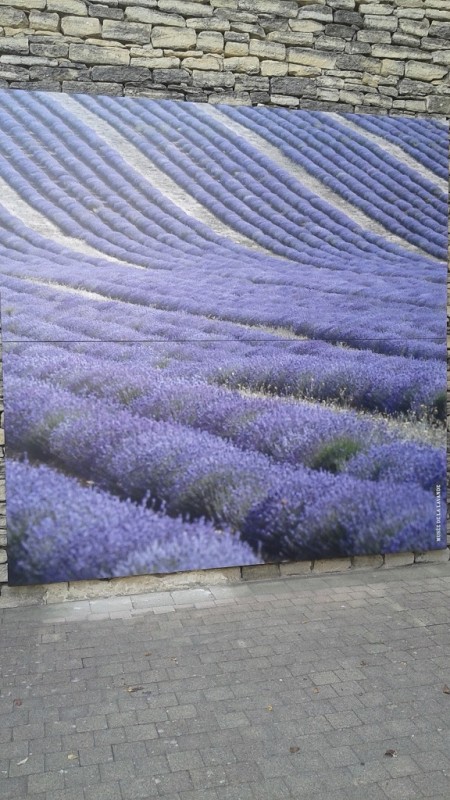
Lavender Fields in Full Bloom
 ?>/images/logo.520x200.jpg)